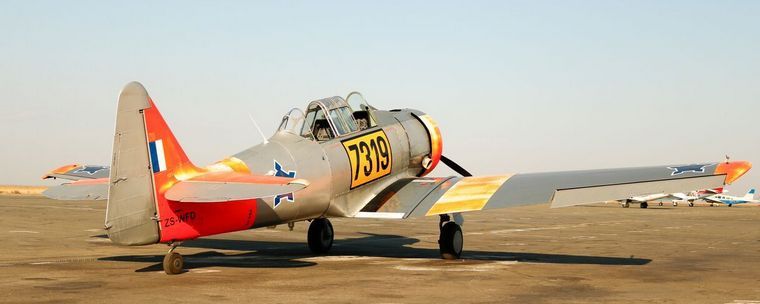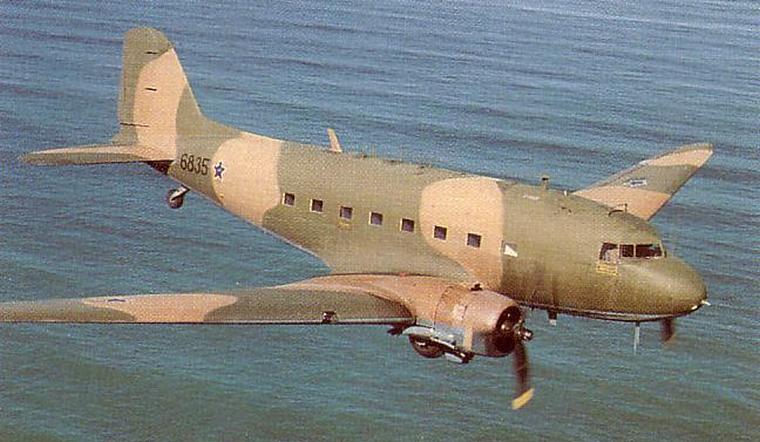Flippie Vermeulen-Half a Century in Aviation
By Willie Bodenstein (Photos supplied)

In 2018 it will be 51 years since Flippie Vermeulen started flying and for almost half a century Flippie has been active in the airline industry flying the legends of the propeller airline age as well as the icons of the jet age. In those 50 years Flippie accumulated 27,000 hours (excluding almost 5,000 hours in simulators) on more than 100 types.
Born in October 1948 in the small village of Gerdau close to Lichtenburg in the now North West province to subsistence farmers, Flippie was the youngest of eight children, seven boys and a girl. It was tough times and to help support his family his Dad, besides farming, worked as a store man at the North West Corporation. Flippie spend most of his early life on the farm at Uitschot close to Ottosdal.
"I was basically raised by Dries my elder brother who was six years older than me." Flippie said. "Dries, was to have a huge influence on my live. I was six and half years old when Dries and I were outside in the garden. In those days, SAA's DC-4's regularly flew over the farm on their way to Windhoek or Keetmanshoop from the then Jan Smuts. On that day one flew high overhead. I did not know what aircraft it was at the time but turning to Dries I said "one day I am going to fly that aircraft."

"At that stage, there were six DC-4's operating in SAA in the twilight of their service lives. In later years, I was fortunate to still manage to fly three of SAA's remaining DC-4' as Part of the SAA Historic Flight and Springbok Classic Air. In 2003 my daughter Petro and I were flying the Dutch (Ex SAA) DC-4 which we at Springbok Classic Air were operating to Katu. The route took us over the old childhood farmhouse. We both suddenly realised what I had predicted almost 50 years before had come true; it was a very emotional moment when we realised there was a three in six chance that the DC-4 we were flying might have been the same one I saw all those years ago." Flippie recalled.
Flippie's Father over time was transferred to the grain depots at Bodenstein, Oppaslaagte, Grootpan and later Lichtenburg where Flippie matriculated.
"All I ever wanted to do was fly so I structured my life and school career to achieve this goal. My parents were not able to support my ambitions and the only option I had was to apply to the SAAF which I did while still at school. In 1966 I received a letter advising me I had been accepted." Flippie said.


The course started in April 1967 and Flippie earned his wings in February 1968. Flippie's first mustering was to 7 Squadron (Harvards) at Youngsfield in Cape Town where he remained for three months before being accepted for a weapons course at Bloemspruit. The course involved all the Harvard Squadron pilots dropping bombs, firing machine guns and launching rockets from Harvards. The top twelve pilots were then posted to 8 Squadron at Bloemspruit where Flippie served out the rest of 1968. During 1969 Flippie was transferred to the Multi Engine Conversion Unit (MECU) at Bloemspruit for a conversion onto the Douglas DC-3. "My first love affair started at the tender age of 19 and was to last to this day" Flippie says!!


"I also met my lovely wife Maryna during this time whilst at Bloemspruit." Flippie said smiling. "I realised as a "short service" transport pilot I had no real future in the SAAF and immediately considered moving to SAA. Fortunately, I was on a four-year short service contract which allowed me to transfer to SAA at any time BEFORE the four-year contract would run out - if I was selected. I applied to SAA and was eight months away from my 21st birthday when the SAA Selection Board under the chairmanship of Captain Pine Pienaar approved my application. I had to wait until my 21st birthday before I could start my wonderful journey with SAA."

On 4 January 1970 Flippie, with 702 hours, was appointed as third pilot on Boeing 707s and reported for his four month conversion course. He flew 707s until 1971 when he was posted to the Vickers Viscount as a co-pilot. Zimbabwe (then Rhodesia) had by then been using Viscounts for several years and their pilots were highly qualified on the type. Sanctions however were hurting and the airline ended up with a surplus of pilots. Twelve of their pilots were seconded to SAA to fly as Captains on the Viscounts. These pilots played a huge part in Flippie's forming years as an airline pilot. As co-pilot Flippie eventually amassed 700 hours on Viscounts. Then it was back to the Jets.

"The 737 was the first jet I flew as co-pilot. It was a small fleet with extremely well qualified and experienced pilots. It was a good consolidation phase of my flying career. There were no changes for four years and it gave me a chance to develop. My big break came in 1976 when I got posted back to the Boeing 707, this time as a co-pilot. We flew domestic routes which was instrumental in developing the routes for the A300 which arrived in 1977. We also did one oversees flight per month on the 707 which really prepared us for our next move onto the new B747-200 which had just recently started service in SAA." Flippie recalled.

SAA received its Boeing 747s in 1972 and Flippie, as co-pilot, found himself flying one of the brand new "Jumbos." Because of sanctions SAA had to fly around the bulge and a huge amount of development work was done not only on the route but on the aircraft, itself at the time.

In 1980, Flippie now thirty-one years old, became a captain on the Boeing 727s. In 1982 the B727's were phased out and he had to move onto the B 737s which he then flew for the next 11 years.
"I purposely stayed on longer on the B737 to be able to fly the new Airbus A320's which were on order. "I wanted to experience the new technology of the Airbus before going on the long-haul fleet again. "Fortunately for me there were a lot of my colleagues who didn't want to fly the new Airbus and my opportunity came up sooner than expected! I now had approximately 7,000 hours on the 737s, and was ready for a change."

When in 1991 SAA received its first Airbus A320's it was only the fifth airline to do so. The others were Lufthansa, BA, Air France and Air Inter. The designated SAA crews with Flippie amongst them were send to Toulouse for their training and conversion onto type. Flippie stayed with the A320 fleet for the next three and a half years before moving onto the 747 Classic long-haul fleet until they were withdrawn from service in 1991.
"I then went onto the B747-400s until they were withdrawn in 2007 and then for the next five years flew Airbus A340s until my retirement in October 2011 - a SAA career which spanned over 42 years logging approximately 26,000 hrs and who knows how many in the simulators "
Retirement for most means just that. For Flippie it opened a whole new career. Barely a month after having left SAA he was back in the left seat, this time flying an Airbus A319 ACJ for a rich Chinese businessman.
"After 42 years of flying for an airline company I thought I was a top gun airline wise." Flippie said. "I have done it all but had no experience in corporate flying. Flying a corporate jet on an ad hoc basis to foreign destinations all the time made me realise flying for airlines was an extremely protected, well-structured and regimented environment. The Corporate flying turned out to be much more challenging and I really had to work hard in the beginning to get on top of it. I always thought the West was the centre of the aviation world - where everything happened.
However, when I flew for the first time flew from Hong Kong to Europe and it took me six hours alone just to get to the border of China and Kazakhstan, I realised how big the world REALLY was. Russia, for instance, encompasses six time zones.
Flippie flew the 319-ACJ for four years accumulating more than 1,000 hours before finally saying farewell to jets. He was then free to pursue his passion, the prop-liners of a previous age. Flippie is however still staying in touch with modern jets as an active A320 Training Captain through his flight school Springbok Air Academy which offers A320 and A330 type rating training.
"I'm the most fortunate person in the whole world. I experienced the prop-liner era from its beginning and still fly them today. I experienced the jet era from its beginning and had the opportunity to fly a modern jet airliner corporately."

During his career Flippie saw the retirement of the Viscount, 707, 727, 747 Classic and 400 from service.
We have only touched on Flippie's career. In 1988 he formed the SAA Historic Flight. In a parallel career he flew 60% of his time for SAA and 40% flying the Historic Flight's classic prop-liners until 2001.
More of Flippie's involvement in the Historic Flight, airshow performances and the birth of Springbok Classic Air in part two of this article.
|
           |























